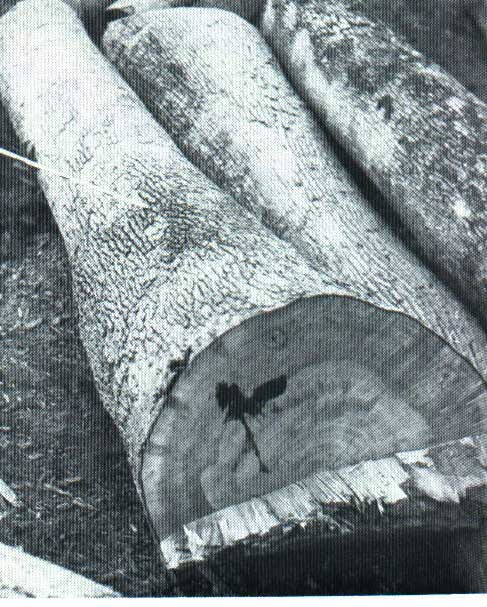
| Home |
| Tutorial |
| Photo Gallery |
| List of Defects |
| Links |
| Bark Distortion |
| Bird Peck |
| Bumps |
| Burls |
| Butt Scars |
| Butt Swells |
| Cankers |
| Conks |
| Epicormic Branches |
| Flanges |
| Flutes |
| Forks |
| Galls |
| Holes |
| Knots |
| Lesions |
| Limbs |
| Ring Shake |
| Rot |
| Seams |
| Soak |
| Splits |
| Wounds |
In standing timber, butt swell may be confused with butt bulge. Butt swell is stimulated by specific site conditions and is limited to a few species. Sounding the butt with an ax or carefully searching for wounds or butt scars ensures identification. In the log, the wood in the butt swell usually is sound; in the butt bulge, the wood is likely to be rotten.
Significance: Butt swell does not reflect log degrade in the underlying wood. Nevertheless, the wood in the swell often is so soft that its uses are limited.
In veneer logs, butt swell is considered a defect; if the tree stem contains veneer-grade logs, the log should be cut at the point where the bole begins to show normal form and taper.
In factory logs, the lumber cut from swelled butts of green, pumpkin, and white ash is graded standard and sold as "cabinet ash". This lumber does not command as high a price as the firm-tectured wood taken from farther up the same tree. At one time, the swelled butts of tupelo were left standing in the woods and the trees were cut above the swell by the use of springboards. This is no longer the case. Presently, these butts are being harvested in increasing numbers for novelty and specialty items.
In construction logs, the swelled butts from all of the species listed contain wood that is so soft textured that it is worthless for the usual products from this class of logs.
In standing trees, butt swell can be indentified with reasonable accuracy. The trees can be cut above the swell in keeping with past practice or cut close to the ground in accord with the current practice of whole tree utilization. If the latter method is followed, the swelled sections can be prepared for use in novelty and specialty products or for conversion into wood chips.

